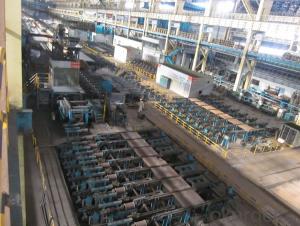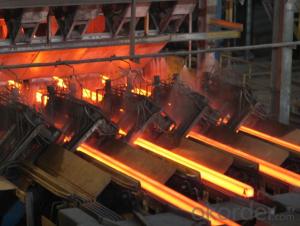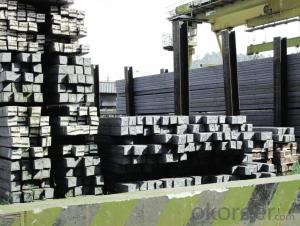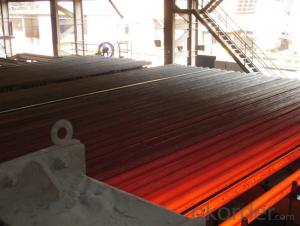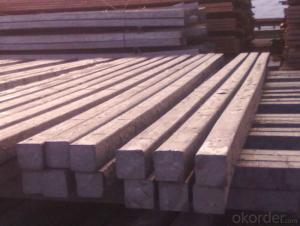Hot Rolled Steel Billet 3SP Standard 115mm
- Loading Port:
- Shanghai
- Payment Terms:
- TT OR LC
- Min Order Qty:
- 100 m.t.
- Supply Capability:
- 10000 m.t./month
OKorder Service Pledge
OKorder Financial Service
You Might Also Like
Structure of Hot Rolled Steel Billet 3SP Standard 115mm

Description of Hot Rolled Steel Billet 3SP Standard 115mm
Prepainted Rolled steel Coil is a kind of coated steel coil/sheet. With the cold rolled steel of different strength and thickness as substrate, it is produced through applying Al-Zn coat on both faces by hot dip process. In its coating, Al accounts for about 55%, Si 1.6%, while the remaining is Zn. Aluminum zinc coils enjoys both the physical protective feature and durability of Al and the electrochemical protective property of Zn. And its surface has bright silver color and regular embossed-like figure, which are highly decorative. RAL Scale Z35 Prepainted Rolled Steel Coil for Construction Roofing

Main Feature of Hot Rolled Steel Billet 3SP Standard 115mm
1.Corrosion resistance: It mainly depends on the zinc protection. When the zinc being worn,
2. Heat resistance: steel sheet has excellent heat resistance, can withstand high temperatures over 300 centigrade, and is similar with aluminized steel high temperature oxidation resistance. It often used in chimney pipes, ovens, fluorescent lighting device and the device cover.
3. Heat reflective: Galvanized steel plate heat-reflective high rate is twice as galvanized steel, often used to make insulation materials. RAL Scale Z35 Prepainted Rolled Steel Coil for Construction Roofing
Applications of Hot Rolled Steel Billet 3SP Standard 115mm
1. Construction and building: roofing; ventilating duct; handrail; partition panel;etc.
2. Electric appliance: refrigerator; washing machine; refrigerator; DVD;etc.
3.Transportation: oil tank; gas tank;road sign; etc.
4.Agriculture constructions :barn; etc.RAL Scale Z35 Prepainted Rolled Steel Coil for Construction Roofing
5.Others:vending machine; game machine; auto parts spare parts etc.
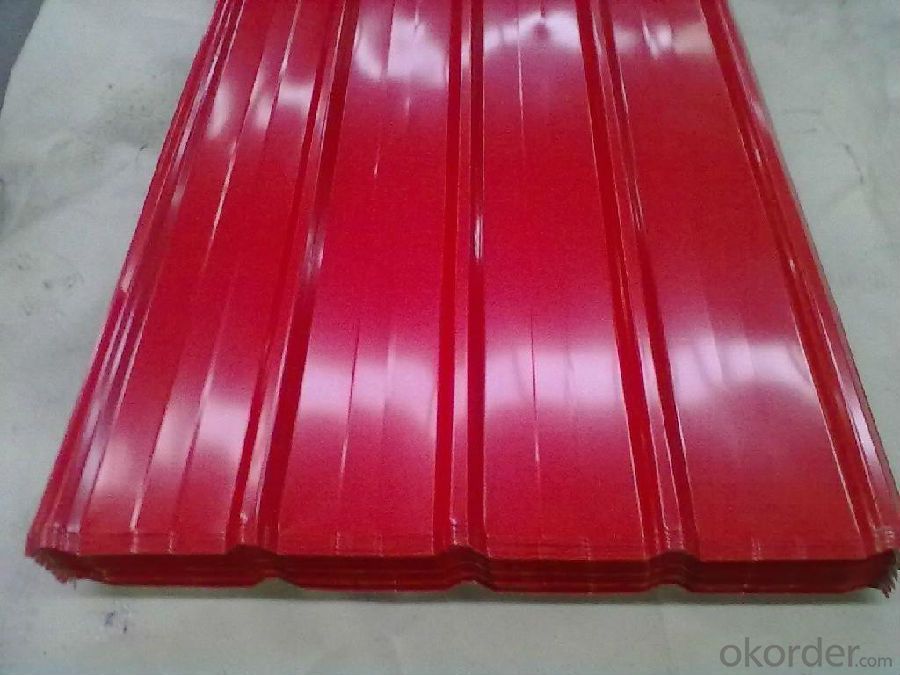
Specifications of Hot Rolled Steel Billet 3SP Standard 115mm
Product | Hot Rolled Steel Billet 3SP Standard 115mm |
Material Grade | SGCC / SGCH / DX51D+AZ, etc |
Thickness | 0.5-3.0mm |
Width | 700-1500mm |
Tolerance | Thickness: +/-0.02mm , Width:+/-2mm |
Zinc-coating | AZ30-150g/m2 |
Technique | Raw material: Hot rolled steel coil --> Cold rolled_>hot dipped galvalume |
Surface | Dried, Chromated, Unoiled,RAL Scale Z35 Prepainted Rolled Steel Coil for Construction Roofing |
Spangle | Regular spangle , small spangle, zero spangle |
ID | 508MM 610MM |
Coil weight | 25MT max |
Export package | Cardboard inner sleeves, Waterproof paper, galvanized steel covered and steel strip packed |
FAQ of Hot Rolled Steel Billet 3SP Standard 115mm
We have organized several common questions for our clients,may help you sincerely:
1. What is the minimum order quantity ?
Our MOQ is 100 mt for each size each specification. Usually we can offer discount if can buy large QTY once. RAL Scale Z35 Prepainted Rolled Steel Coil for Construction Roofing
2. How long can we receive the product after ordering?
Our general delivery time is 30 days after confirmation, but so some special orders, we have offer special delivery time
3. How to guarantee the quality of the products?
We have established the international advanced quality management system ,every link from raw material to final product we have strict quality test;We resolutely put an end to unqualified products flowing into the market. At the same time, we will provide necessary follow-up service assurance.
4. What is the payment?
We accept T/T, L/C
- Q:What are the different methods of steel billet cutting?
- There are several common methods for cutting steel billets, including sawing, shearing, abrasive cutting, and flame/plasma cutting. Sawing involves using a high-speed circular saw blade to cut through the billet, while shearing involves using a guillotine-like tool to apply a shearing force and cut the billet. Abrasive cutting utilizes a high-speed abrasive wheel to grind through the steel, and flame or plasma cutting involves using a focused flame or plasma arc to melt and cut the billet. Each method has its own advantages and disadvantages depending on the specific requirements of the project.
- Q:What is the lifespan of a steel billet?
- The lifespan of a steel billet is indefinite as long as it is properly stored and maintained, making it a durable and long-lasting material.
- Q:What are the different types of steel billet packaging?
- There are several types of steel billet packaging, including wooden crates, steel or plastic wrapping, and steel wire or strapping.
- Q:What are the different methods of steel billet surface plating?
- There are several different methods of steel billet surface plating, each with its own advantages and applications. Some of the most common methods include: 1. Electroplating: This is a widely used method where an electric current is used to deposit a layer of metal onto the surface of the steel billet. The billet is submerged in a solution containing metal ions, and when the current is applied, the metal ions are attracted to the steel surface, forming a thin coating. 2. Hot-dip galvanizing: In this method, the steel billet is dipped into a bath of molten zinc. The high temperature causes the zinc to bond with the steel, forming a protective layer. This process is commonly used for steel structures that will be exposed to harsh environments or corrosive elements. 3. Powder coating: This technique involves applying a dry powder to the surface of the steel billet, which is then heated to form a protective layer. Powder coating offers excellent durability, resistance to corrosion, and a wide range of color options. 4. Physical vapor deposition (PVD): PVD is a method where a thin film of metal is deposited onto the surface of the steel billet through a physical process such as evaporation or sputtering. This technique is commonly used for decorative purposes and to enhance the hardness and wear resistance of the steel surface. 5. Chemical conversion coating: This process involves treating the steel billet with a chemical solution that forms a protective layer on the surface. Common conversion coatings include phosphate and chromate coatings, which provide corrosion resistance and improve paint adhesion. 6. Thermal spraying: In this method, a heated material, typically a metal or ceramic powder, is sprayed onto the steel billet surface using a high-velocity gas or flame. The sprayed material forms a coating, providing enhanced protection against wear, corrosion, and high temperatures. Each of these methods has its own benefits and is suitable for different applications. The choice of plating method depends on factors such as the desired level of protection, cost, aesthetics, and specific requirements of the steel billet's end use.
- Q:How are steel billets used in the manufacturing of medical equipment?
- Steel billets are an essential raw material used in the manufacturing of medical equipment. These billets are semi-finished steel products that serve as a starting point for various manufacturing processes. In the medical equipment industry, steel billets are utilized to produce a wide range of components and devices that are crucial for healthcare professionals and patients. Firstly, steel billets are often transformed into stainless steel through a process called stainless steel casting. Stainless steel is highly desirable in medical equipment manufacturing due to its excellent corrosion resistance, durability, and hygienic properties. It is commonly used in the production of surgical instruments, such as scalpels, forceps, and scissors, as well as implantable devices like orthopedic implants, pacemakers, and stents. Furthermore, steel billets are also used to manufacture medical equipment components through precision machining. These billets are machined into various shapes and sizes, allowing the production of parts like connectors, valves, brackets, and frames for medical devices and equipment. Precision machining ensures that these components meet the strict quality and dimensional requirements necessary for medical applications. In addition, steel billets are employed in the production of medical equipment casings and enclosures. These components provide protection and support for sensitive internal components, ensuring the durability and longevity of medical devices. Steel billets are often used to create casings for devices like X-ray machines, CT scanners, and MRI machines, as well as smaller equipment like infusion pumps and monitors. Overall, steel billets play a vital role in the manufacturing of medical equipment by providing the necessary raw material for the production of components, casings, and instruments. The inherent properties of steel, such as strength, durability, and corrosion resistance, make it an ideal material for medical applications. The use of steel billets ensures the production of high-quality, reliable, and safe medical equipment that is essential for the healthcare industry.
- Q:What are the different methods of steel billet casting?
- There are several methods of steel billet casting, including continuous casting, ingot casting, and direct casting. Continuous casting is the most common method, where molten steel is poured into a water-cooled mold and solidifies into a continuous strand. Ingot casting involves pouring molten steel into individual molds to create solid metal ingots. Direct casting, also known as hot top casting, involves pouring molten steel directly into a single mold without using any intermediate steps. Each method has its own advantages and is used based on the specific requirements of the steel billet.
- Q:How do steel billets contribute to the aerospace industry?
- Steel billets play a crucial role in the aerospace industry by providing the necessary raw material for manufacturing various components and structures used in aircraft. These billets, which are semi-finished metal forms, are typically produced through a process called continuous casting, where molten steel is poured into a mold to create a solid billet shape. Once the steel billets are formed, they are further processed into different aerospace components through various manufacturing techniques such as forging, machining, and heat treatment. These processes allow the steel billets to be shaped into specific forms, such as engine components, landing gear parts, structural frames, and other critical aerospace components. The use of steel billets in the aerospace industry offers several advantages. Firstly, steel is known for its high strength, durability, and excellent mechanical properties, making it a suitable material for applications where safety and reliability are of utmost importance, such as in the aerospace sector. Steel billets can withstand extreme temperatures, pressure, and stress, making them ideal for critical parts that need to perform under demanding conditions. Additionally, steel billets provide cost-effectiveness and versatility in manufacturing. Steel is widely available, making it a relatively affordable material compared to other metals used in the aerospace industry. Moreover, the ability to shape and process steel billets into various forms and sizes allows for flexibility in designing and producing aerospace components, ensuring they meet the specific requirements and standards of aircraft manufacturers. Another key contribution of steel billets to the aerospace industry is their compatibility with advanced manufacturing technologies. Steel can be easily machined, welded, and joined, enabling the integration of complex features and structures in aerospace components. This compatibility with modern manufacturing techniques allows for the production of lightweight, yet robust, parts, contributing to overall fuel efficiency and improved performance of aircraft. In conclusion, steel billets are vital to the aerospace industry as they provide the necessary raw material for manufacturing critical components and structures used in aircraft. Their high strength, durability, cost-effectiveness, and compatibility with advanced manufacturing technologies make steel billets an essential ingredient in building safe, reliable, and efficient aerospace systems.
- Q:What are the potential applications of steel billets in the transportation sector?
- Due to their strength, durability, and versatility, steel billets offer a wide range of potential applications in the transportation sector. One primary use is in the manufacturing of various vehicle components, such as engine parts, suspension systems, axles, and other critical parts that require high strength and resistance to wear and tear. Moreover, steel billets can be utilized in the construction of railway tracks, bridges, and tunnels. With its high tensile strength, steel is an ideal material for infrastructure projects as it can withstand heavy loads and provide long-lasting performance. It is also suitable for manufacturing shipbuilding components like hulls, propellers, and deck structures, offering excellent corrosion resistance and structural integrity in marine environments. Additionally, steel billets find use in the production of transportation equipment like trailers, trucks, and buses. Its strength and durability make it an ideal material for constructing the chassis and frames of these vehicles, ensuring their safety and longevity. In the automotive industry, steel billets are commonly used for producing car bodies and frames. The lightweight yet robust characteristics of steel make it a preferred choice for enhancing fuel efficiency and crashworthiness in vehicles. Furthermore, manufacturers can shape steel billets into intricate designs, allowing them to create aesthetically pleasing and aerodynamic vehicle structures. In conclusion, the strength, durability, and versatility of steel billets make them essential in the transportation sector. They are used in various applications, ranging from vehicle components to infrastructure projects. By ensuring safety, reliability, and longevity, steel billets play a vital role in the industry.
- Q:How are steel billets used in the production of automotive components?
- Steel billets are a crucial raw material used in the production of automotive components. In the manufacturing process, steel billets are heated and then forged or rolled into various shapes and sizes to create the desired automotive parts. These billets serve as a starting point for the production of components such as engine blocks, crankshafts, connecting rods, axles, and suspension parts. The high strength and durability of steel make it an ideal material for these critical components, ensuring the safety and performance of automobiles. Once heated, the steel billets are subjected to various shaping processes, such as hot forging or hot rolling. Hot forging involves applying pressure to the heated billet using a die to create the desired shape. This process not only gives the component its final shape but also improves its mechanical properties by aligning the steel's grain structure. Hot rolling, on the other hand, involves passing the heated billet through a series of rolling mills to gradually reduce its thickness and shape it into a specific profile. This process is commonly used for producing long automotive components like axles or suspension parts. After the shaping process, the automotive components undergo additional manufacturing steps like heat treatment, machining, and surface finishing to enhance their strength, precision, and aesthetic appeal. Steel billets offer several advantages in automotive component production. Their excellent mechanical properties, including high strength, toughness, and wear resistance, make them ideal for withstanding the demanding conditions and loads experienced by automotive parts. Additionally, steel's ability to be easily shaped and formed allows manufacturers to create complex and intricate designs, ensuring optimal functionality and performance. In conclusion, steel billets play a vital role in the production of automotive components by providing the raw material that is shaped and formed into various critical parts. The strength, durability, and versatility of steel make it an essential material for ensuring the safety, reliability, and performance of automobiles.
- Q:How are steel billets used in the production of electrical appliances?
- Steel billets are used in the production of electrical appliances as a raw material that is shaped and formed into various components such as casings, frames, brackets, and other structural parts. These billets are melted, cast, and rolled into the desired shape and size, providing the necessary strength, stability, and durability required for electrical appliances.
1. Manufacturer Overview |
|
|---|---|
| Location | |
| Year Established | |
| Annual Output Value | |
| Main Markets | |
| Company Certifications | |
2. Manufacturer Certificates |
|
|---|---|
| a) Certification Name | |
| Range | |
| Reference | |
| Validity Period | |
3. Manufacturer Capability |
|
|---|---|
| a)Trade Capacity | |
| Nearest Port | |
| Export Percentage | |
| No.of Employees in Trade Department | |
| Language Spoken: | |
| b)Factory Information | |
| Factory Size: | |
| No. of Production Lines | |
| Contract Manufacturing | |
| Product Price Range | |
Send your message to us
Hot Rolled Steel Billet 3SP Standard 115mm
- Loading Port:
- Shanghai
- Payment Terms:
- TT OR LC
- Min Order Qty:
- 100 m.t.
- Supply Capability:
- 10000 m.t./month
OKorder Service Pledge
OKorder Financial Service
Similar products
New products
Hot products
Related keywords
